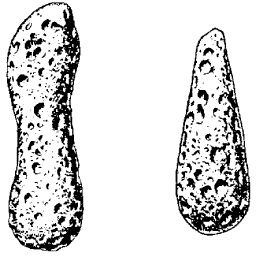 |
Science Frontiers ONLINE No. 115: Jan-Feb 1998 |
|
|
Tektite Mysteries
Tektites are small glassy bodies found strewn on and near the surface in several regions of the world. They come in various shapes: droplets, buttons, even dumbbells. By general agreement, tekites are attributed to meteoric or cometary impacts that melt terrestrial rocks and splash liquid droplets into the atmosphere. There they are shaped by aerodynamic forces and solidify. This scenario is all very reasonable, but some nagging problems remain.
Where-o-where is that crater? 770,000 years ago, a huge meteor hit somewhere on earth and strewed an immense batch of tektites and microtektites over fully 10% of our planet's surface (about 5 x 107 square kilometers). This is called the "Australasian strewn field." Such a recent cataclysm must have left a large and inescapable crater somewhere. The problem is that no one has yet found it. (Ref. 1)
Many lines of evidence suggest that the missing crater is in Indochina. C.C. Schnetzler and J.F. McHone located four likely structures in Laos from Landsat images. However, visits to these areas found no evidence of an impact. (Ref. 2) So, this mystery persists.
How were the Muong Nong tektites formed? Muong Nong tektites are unusually large (up to 24 kilograms), layered tektites. They are found in an area 1,000 kilometers in extent from Hainan Island to southern Indochina. Their large sizes imply that they are probably close to the missing crater mentioned above. Still unresolved is whether they were originally puddles of molten rock near the elusive crater or local ejecta analogous to volcanic bombs. (Ref. 1)
Is the "age paradox" finally resolved? Some Australian geologists have stratigraphically dated the Australasian tektites as being just a few thousand rather than 770,000 years old. (SF#8) The 770,000-year figure is derived from the presence of Australasian microtekites at the Brunhes-Matuyama magnetic reversal and is, therefore, a "magnetostratigraphic" date. Recent excavations by now seem to confirm R. Fudali's assessment that all tektites and microtektites in the Australasian strewn field are definitely 770,000 years old. (Ref. 3)
References
Ref. 1. Taylor, S.R.; "Tektites: Some Unresvolved Problems," Meteoritics and Planetary Science, 32:4, 1997.
Ref. 2. Schnetzler, C.C. and McHone, J.F.; "Source of Australasian Tektites: Investigating Possible Impact Sites in Laos," Meteoritics and Plane tary Science, 31:73, 1996.
Ref. 3. Fudali, R.; "The Stratigraphic Age of Australites Revisited," Meteoritics, 28:114, 1993.
Comment. Still puzzling is why so many Australasian tektites show up in recent sediments. One theory is that humans valued these glassy objects and did some anthropomorphic strewing.
 | Dumbbell- and tear-shaped tektites picked up in Indochina. |